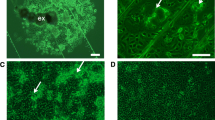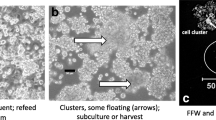Summary
Three mosquito cell cultures designated as Suitor's clone ofAedes aegypti, Culiseta inornata, andAedes vexans were shown to be moth by immunological, karyological, and isozyme analyses. The cells reacted with rabbit antimoth serum but not rabbit antimosquito serum. Chromosome analyses indicated Lepidopteran rather than Dipteran morphology, and three isozyme systems were confirmative. Any one of these assays would be sufficient to indicate that contamination had occurred and could be used as a periodic check for identity of cell cultures. Morphology and growth characteristics are also valid criteria to distinguish between these particular orders of insect cells.
Similar content being viewed by others
References
Grace, T. D. C. 1962. Establishment of four strains of cells from insect tissues grown in vitro. Nature (Lond.) 195: 788–789.
Singh, K. R. P. 1967. Cell cultures derived from larvac ofAedes albopictus (Skuse) andAedes aegypti (L.) Curr. Sci. 36: 506–508.
Peleg, J. 1968. Growth of arboviruses in monolayers from subcultured mosquito embryo cells. Virology 35: 617–619.
Brand, K. G., and J. Syverton. 1962. Results of species specific hemagglutination test on “transformed,” nontransformed and primary cell cultures. J. Natl. Cancer Inst. 28: 147–157.
Herrick, P. R., G. W. Baumann, D. J. Merchant, M. C. Schearer, C. Shipman, Jr., and R. G. Brackett. 1970. Serologic and karyologic evidence of incorrect identity of an animal cell line (guinea pig spleen). In Vitro 6: 143–147.
Cell Culture Colletion Committee. 1964. A culture collection of animal cell strains. Science 146: 241–243.
McGarrity, G. M., and L. L. Coriell. 1971. Procedures to reduce contamination of cell cultures. In Vitro 6: 257–265.
Suitor, E. C., L. L. Chang, and H. H. Lin. 1966. Establishment and characterization of a clone from Grace's in vitro cultured mosquito (Aedes aegypti L.) cells. Exp. Cell Res. 44: 572–578.
Yunker, C. E., J. L. Vaughn, and J. Cory. 1967. Adaptation of an insect cell line (Grace's Antheraea cells) to medium free of insect hemolymph. Science 155: 1565–1566.
Sweet, B. H., and J. S. McHale 1970. Characterization of cell lines derived fromCuliseta inornata andAedes vexans mosquitoes. Exp. Cell Res. 61: 51–63.
Greene, A. E., and J. Charney. 1970. Characterization and identification of insect cell cultures. In: E. Weiss (Ed.),Arthropod Cell Cultures and Their Application to the Study of Viruses. Vol. 55,Current Topics in Microbiology and Immunology. springer-Verlag, Berlin, Heidelberg, New York, pp. 51–61.
Charney, J., and L. L. Coriell. 1964. Demonstration, purification and partial characterization of abnormal (HSL) antigens in stable human cell line. J. Natl. Cancer Inst. 33: 285–301.
Crowle, A. J. 1958. A simplified micro double-diffusion agar precipitin technique. J. Lab. Clin. Med. 52: 784–787.
Johnson, J. M., C. G. Kanapi, R. H. Richardson, M. R. Wheeler, and N. S. Stone. 1966. An operational classification of Drosophila esterases for species comparisons. The University of Texas Publications, p. 517.
Shaw, C. R., and A. L. Koen. 1968. Starch gel zone electrophoresis of enzymes. In: I. Smith (Ed.),Zone Electrophoresis. 2nd ed., Vol. 2. John Wiley, New York.
Nichols, W. W., C. Bradt, and W. Bowne. 1970. Cytogenetic studies on cell in culture from the class Insecta. In: E. Weiss (Ed.),Arthropod Cell Cultures and Their Application to the Study of Viruses. Vol. 55,Current Topics in Microbiology and Immunology. Springer-Verlag, Berlin, Heidelberg, New York, pp. 61–69.
Thomson, J. A., and T. D. C. Grace. 1963. Cytological observations on cell strains cstablished in culture from insect ovarian tissue. Aust. J. Biol. Sci. 16: 869–876.
Greene, A. E., L. L. Coriell, and J. Charney. 1969. Species identification of poikilothermie tissue culture cells. In: M. Mizell (Ed.)Biology of Amphibian Tumors. Springer-Verlag, New York, pp. 279–295.
Coriell, L. L. 1968. Laminar flow systems for sterile work. In: Cell cultures for virus vaccine production. Natl. Cancer Inst. Monogr. 29: 569–574.
Grace, T. D. C. 1966. Establishment of a line of mosquito (Aedes aegypti L.) cells grown in vitro. Nature (Lond.) 211: 366–367.
Ibraham, A. N., and B. H. Sweet. 1970. Antigenic relationships of mosquito cell lines as determined by immuno-diffusion techniques. In: E. Weiss (ed.)Arthropod Cell Cultures, and Their Application to the Study of Viruses. Curr. Topics Microbiol. Immunol. 55: 47–51.
Author information
Authors and Affiliations
Additional information
These studies were supported by Grant CA-04953-12 from the National Cancer Institute; General Research Support Grant FR-5582 from the National Institutes of Health; and Grant-in-Aid Contract M-43 from the State of New Jersey.
Recipient of Research Career Award 5-K3-16,749 from the National Institutes of Health.
Rights and permissions
About this article
Cite this article
Greene, A.E., Charney, J., Nichols, W.W. et al. Species identity of insect cell lines. In Vitro 7, 313–322 (1972). https://doi.org/10.1007/BF02661721
Issue Date:
DOI: https://doi.org/10.1007/BF02661721




